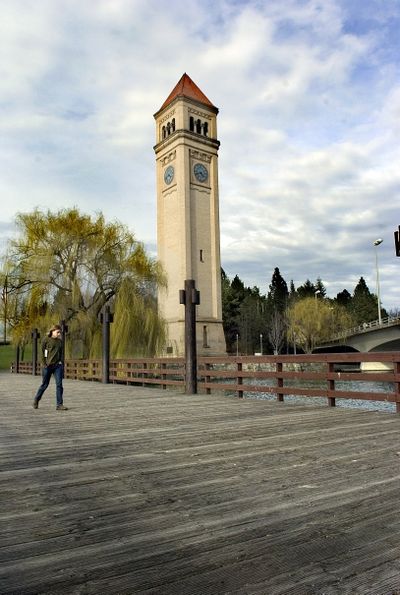Clock Tower originally kept trains on time

Probably the best 360-degree view of the city from the downtown area is atop the 155-foot-tall Clock Tower in Riverfront Park. And pretty much the only person who gets to see it is David Randolph, laborer foreperson for the city of Spokane. He’s the man who winds the clock.
Although the clock can be wound to run for eight days, Randolph makes the climb once every seven days – allowing a day’s leeway, just in case – to ensure that the clock runs, well, like clockwork. It’s a combination of 133 steps and ladder rungs up to reach the little room where the mechanism for the clock’s four faces is housed. The crank has a 2-foot-long handle, and it takes 99 turns of the crank to keep things working for the next week.
“The vista from up there is just unbelievable,” he said. “I’ve been hoping for quite a while to get funding for an elevator so guests to the park can ride up to see the inner workings of the clock and see the panoramic view. There is part of an old elevator shaft in the tower, but it doesn’t reach the clock.”
Randolph said he does recognize that as the park will be 40 years old in 2014, there are probably other repair and maintenance issues that need to be taken care of first. “Still, it could be a nice revenue source for the city.”
Randolph has been taking care of the clock for the past 20 years, including greasing, cleaning and general maintenance. It’s not always easy. This year two bushings needed to be repaired, and a master clockmaker was found to reconstruct them.
When one of the windowpanes on a clock face was damaged and a new one installed some years back, it had to be sandblasted to match the texture of the 100-year-old glass it replaced. Another time, when there was a failure of the 8-inch-long spring-steel plates on which the 3-inch-wide, 500-pound zinc pendulum swings, new ones had to be handmade and hardened. “We needed to get the right hardness and tension or it wouldn’t work,” he said. “While we just needed two, we went ahead and had 12 made, so we’re set for the future.”
When the Clock Tower and its attached Great Northern Railway Depot building were listed on the National Register of Historic Places in 1972, the 9-foot-across clock faces were declared the largest timepieces in the Pacific Northwest. And they were then and today remain quite hefty. The glass faces alone total more than 1,400 pounds.
As is pretty well known in the region, the Clock Tower – now one of the most recognized symbols of the city – is all that remains of the railway depot, which was demolished in 1972-’73 to make way for Expo ’74, the world’s fair the city held in the area of downtown Spokane that was to become Riverfront Park. The Clock Tower was retained as a memorial to the city’s railroading history.
The depot itself was considered the finest railroad station west of Chicago when it opened on May 30, 1902. The clock in the tower began keeping time at high noon on June 20 of that year. Over the years, rail lines connected through the depot – from the north, linking Spokane with the rich lumber and farming areas of northeastern Washington, also uniting Spokane with Canada. And the Spokane and Inland Empire Railway connected Spokane with both North Idaho and the wheat-growing areas to the south of the city. These rail lines, along with the Great Northern (their future parent), helped Spokane become headquarters for regional mining operations as well.
A smaller rail line – the Spokane, Portland and Seattle Railway – known as the “Northwest’s Own Railroad,” according to historical documents, also operated through the depot, connecting Spokane with Pasco, the Big Bend area and Portland.
The Clock Tower still chimes the hours, but it also serves many other purposes now, too. Randolph recalls that when the Harry Potter films first opened in Spokane, he’d have to fill smoke machines that would go off high in the tower each hour as a promotion for the films. He used a green gel on the lights to tint the color of the smoke. “Multiple calls went to the fire department reporting that the tower was on fire,” Randolph said, “even though the smoke people were seeing was green.”
Randolph also hangs banners from the tower, as needed, and is sometimes stationed high up during fireworks shows to check the grounds for possible fires or problems. Useful for publicity, as a symbol of the city and a reminder of the past, the Clock Tower still does something extremely well, as it has for 109 years – it keeps pretty good time for the city.